Research on Safety Risk Evaluation System for Seepage in Ship Lock Foundation Pit Engineering
Abstract
:1. Introduction
2. Seepage Calculation of Ship Lock Foundation Pit Engineering
2.1. Project Overview and FEM Model
2.2. FEM Model
2.3. Principles of Multi-Objective Optimization
3. Safety Risk Assessment System for Seepage in Ship Locks
3.1. Seepage Calculation Result
3.2. Evaluation Index
3.2.1. Silting of Dewatering Well
3.2.2. Defect in Diaphragm Wall
3.3. Performance Function Based on the Efficiency of a Precipitation Well
3.4. Performance Function Based on Ground Wall Defects
3.5. Objective Function for Risk Assessment
4. Conclusions
- (1)
- The numerical analysis indicates that when the anti-seepage system is intact, the seepage resistance of the anti-seepage wall remains within normal parameters, and drainage in the basement operates effectively. The zero-pressure boundary is situated 2 m below the bottom slab, with each soil layer’s gradient remaining below the critical threshold, thereby satisfying design specifications.
- (2)
- Clogging of dewatering wells and defects in the diaphragm wall significantly influence the seepage characteristics within the pit. Increased severity of clogging in dewatering wells correlates with a larger area of the diaphragm wall defects, resulting in heightened water head elevation. Furthermore, assessing seepage failure based on gradient metrics proves inadequate under conditions characterized by dewatering well clogging.
- (3)
- An effectiveness function was derived from two risk factors: dewatering well clogging and diaphragm wall defects; distinct weights were assigned to these factors to formulate a comprehensive evaluation function for seepage failure risk. This approach enables an effective delineation of safe ranges concerning seepage actions.
Author Contributions
Funding
Data Availability Statement
Acknowledgments
Conflicts of Interest
References
- Niu, Z.Y.; Niu, J.Y. Research on calculation of node cost water prices for long distance water diversion projects: A case study of Nanshan Canal. Water Res. Dev. Res. 2024, 278, 83–89. (In Chinese) [Google Scholar]
- Farinha, A.; Sousa, L.; Reis, L. Evaluating lock gates’ strength due to ship collisions: A Douro waterway lock gates case study. Mar. Struct. 2018, 60, 261–278. [Google Scholar] [CrossRef]
- Li, W.J.; Dai, J.L.; Xiao, Y.; Yang, S.F.; Chen, S. Estimating waterway freight demand at Three Gorges ship lock on Yangtze River by backpropagation neural network modeling. Marit. Econ. Logist. 2020, 23, 495–521. [Google Scholar] [CrossRef]
- Xu, I.C.; Xuan, G.X.; Li, Y.; Li, Z.H.; Hu, Y.G.; Jin, Y.Z.; Huang, Y. Study on the squat of extra-large scale ship in the Three Gorges ship lock. Ocean Eng. 2016, 123, 65–74. [Google Scholar] [CrossRef]
- Todor, B.; Vladimir, B.; Filip, K.; Željko, K. Adaptable Fuzzy Expert System for Ship Lock Control Support. J. Navig. 2016, 69, 1341–1356. [Google Scholar]
- Feng, Y.T.; Yan, F.Y.; Wu, L.R.; Lu, G.Y.; Liu, T.Y. Numerical Analyses of Slope Stability Considering Grading and Seepage Prevention. Water 2023, 15, 1745. [Google Scholar] [CrossRef]
- Jin, L.X.; Wei, J.J.; Luo, C.W.; Tian, Q.H. Slope stability analysis based on improved radial movement optimization considering seepage effect. Alex. Eng. J. 2023, 79, 591–607. [Google Scholar] [CrossRef]
- Qu, X.L.; Zhang, Y.K.; Chen, Y.R.; Chen, Y.Y.; Qi, C.Z.; Pasternak, E.; Dyskin, A. A Coupled Seepage–Deformation Model for Simulating the Effect of Fracture Seepage on Rock Slope Stability Using the Numerical Manifold Method. Water 2023, 15, 1163. [Google Scholar] [CrossRef]
- Jiang, X.G.; Zhu, Z.Y.; Chen, H.Y.; Deng, M.F.; Niu, Z.P.; Deng, H.X.; Zou, Z.Y. Natural dam failure in slope failure mode triggered by seepage. Geomat. Nat. Hazards Risk 2020, 11, 698–723. [Google Scholar] [CrossRef]
- Ansari, S.U.; Hussain, M.; Ahmad, S.M.; Rashid, A.; Mazhar, S. A stabilized mixed finite element method for Darcy flow. Comput. Methods Appl. Mech. Eng. 2017, 191, 4341–4370. [Google Scholar] [CrossRef]
- Rui, H.X.; Zhang, J.Y. A stabilized mixed finite element method for coupled Stokes and Darcy flows with transport. Comput. Methods Appl. Mech. Eng. 2017, 315, 169–189. [Google Scholar] [CrossRef]
- Song, J.P.; Rui, H.G. A combined stabilized mixed finite element and discontinuous Galerkin method for coupled Stokes and Darcy flows with transport. Comput. Math. Appl. 2022, 120, 92–104. [Google Scholar] [CrossRef]
- Ren, D.C.; Liu, Y.C.; Zhu, G.S. Analysis on seepage of high excavated slopes of cracked rock in the ship locks of Three Gorges. Chn. J. Geotech. Eng. 2007, 11, 180–183. (In Chinese) [Google Scholar]
- Shi, C.G.; Sun, X.H.; Liu, S.L.; Cao, C.Y.; Liu, L.H.; Lei, M.F. Analysis of Seepage Characteristics of a Foundation Pit with Horizontal Waterproof Curtain in Highly Permeable Strata. Water 2021, 13, 1303. [Google Scholar] [CrossRef]
- Huang, J.S.; Gu, L.C.; He, Z.; Yu, J. Analytical Solution for the Steady Seepage Field of an Anchor Circular Pit in Layered Soil. Buildings 2023, 14, 74. [Google Scholar] [CrossRef]
- Tracy, F.T.; Vahedifard, F. Analytical solution for coupled hydro-mechanical modeling of infiltration in unsaturated soils. J. Hydrol. 2022, 612, 128198. [Google Scholar] [CrossRef]
- Deng, Y.S.; Guo, Y.; Zou, B.P.; Wang, J.X.; Liu, X.T.; Chen, Q.Z.; Kong, B.W.; Liang, S.J. Failure analysis and zoning control of water gushing in foundation pit. Eng. Fail. Anal. 2023, 145, 107029. [Google Scholar] [CrossRef]
- Xiong, H.; Zhang, Z.M.; Sun, X.M.; Yin, Z.Y.; Chen, X.S. Clogging effect of fines in seepage erosion by using CFD–DEM. Comput. Geotech. 2022, 152, 105013. [Google Scholar] [CrossRef]
- Nan, X.; Liu, X.X.; Wu, B.Q.; Zhang, H.M.; Song, K.L.; Wang, X.D. Coupled CFD-DEM simulation and experimental study of particle distribution and accumulation during tailings seepage process. J. Clean. Prod. 2023, 427, 139229. [Google Scholar] [CrossRef]
- Wei, F.R.; Wang, H.N.; Zeng, G.S.; Jiang, M.J. Seepage flow around twin circular tunnels in anisotropic ground revealed by an analytical solution. Undergr. Space 2023, 10, 1–14. [Google Scholar] [CrossRef]
- Hu, Z.; Yang, Z.X.; Guo, N.; Zhang, Y.D. Multiscale modeling of seepage-induced suffusion and slope failure using a coupled FEM–DEM approach. Comput. Methods Appl. Mech. Eng. 2022, 398, 115177. [Google Scholar] [CrossRef]
- Yu, J.K.; Yang, X.X.; Deng, P.B.; Chen, W.B. Analytical Solution for a Steady Seepage Field of a Foundation Pit in Layered Soil. Int. J. Geomech. 2022, 22, 1342–1367. [Google Scholar] [CrossRef]
- Yuan, C.Y.; Hu, Z.H.; Zhu, Z.; Yuan, Z.J.; Fan, Y.X.; Guan, H.; Li, L. Numerical Simulation of Seepage and Deformation in Excavation of a Deep Foundation Pit under Water-Rich Fractured Intrusive Rock. Geofluids 2021, 2021, 6628882. [Google Scholar] [CrossRef]
- Tony, L.; Zhan, T.; Qiu, Q.W.; Xu, W. Analytical solution for infiltration and deep percolation of rainwater into a monolithic cover subjected to different patterns of rainfall. Comput. Geotech. 2016, 77, 1–10. [Google Scholar]
- Bi, J.F.; Jiang, H. Water infiltration in drained circular tunnels: An analytical solution and its simplification. Geotechnique 2023, 17, 1–12. [Google Scholar] [CrossRef]
- Wu, L.Z.; He, B.; Peng, J.B. Analysis of Rainfall-Caused Seepage into Underlying Bedrock Slope Based on Seepage Deformation Coupling. Int. J. Geomech. 2024, 24, 263497. [Google Scholar] [CrossRef]
- Sharma, V.; Fujisawa, K.; Murakami, M. Space-Time Finite Element Method for Transient and Unconfined Seepage Flow Analysis. Finite Elem. Anal. Des. 2023, 197, 103632. [Google Scholar] [CrossRef]
- Lei, Y.; Dai, Q.H.; Zhang, B.; Yang, J.S. A Gradient Smoothing Technique-Based S-FEM for Simulating the Full Impacts of Anomalies on Seepage Solutions and its Application in Multi-Parameter Seepage Inversion. Water Resour. Manag. 2024, 38, 753–773. [Google Scholar] [CrossRef]
- Wan, Z.Y.; Yun Li, Y.; Wang, X.G.; An, J.F.; Cheng, L.; Liao, Y.P. Effect of ship-lock-induced surges on navigation safety in a branched lower approach channel system. J. Hydroinform. 2022, 24, 481–496. [Google Scholar] [CrossRef]
- Wang, H.Z.; Zou, Z.J. Numerical study on hydrodynamic interaction between a berthed ship and a ship passing through a lock. Ocean Eng. 2014, 88, 409–425. [Google Scholar] [CrossRef]
- Zhou, Z.; Zhou, Z.W.; Li, Y.B.; Vanapalli, K.S.; Huang, H.L. Analysis of deformation and leakage performance of Xiluodu reservoir dam foundation using a coupled two-factor stress-deformation-seepage model. Eng. Geol. 2022, 310, 106871. [Google Scholar] [CrossRef]
- Fan, X.L.; Wu, Z.Y.; Liu, L.J.; Wen, Y.Q.; Yu, S.; Zhao, Z.P.; Li, Z.F. Analysis of Sluice Foundation Seepage Using Monitoring Data and Numerical Simulation. Adv. Civ. Eng. 2019, 31, 1–15. [Google Scholar]
- Du, K.L.; Li, J.Y.; Wang, H.; Zhang, J. Multi-objective multi-criteria evolutionary algorithm for multi-objective multi-task optimization. Complex Intell. Syst. 2022, 9, 1211–1228. [Google Scholar] [CrossRef]
- Wang, Z.Y.; Wallace, T.G.; Rangaiah, G.P.; Wu, Z. Machine learning aided model predictive control with multi-objective optimization and multi-criteria decision making. Comput. Chem. Eng. 2023, 179, 108414. [Google Scholar] [CrossRef]
- Yazdani, H.; Baneshi, M.; Yaghoubi, M. Techno-economic and environmental design of hybrid energy systems using multi-objective optimization and multi-criteria decision making methods. Energy Convers. Manag. 2022, 282, 116873. [Google Scholar] [CrossRef]
- Hou, W.Y.; Wen, Y.Q.; Deng, G.; Zhang, Y.Y.; Wang, X.N. A multi-target prediction model for dam seepage field. Front. Earth Sci. 2023, 11, 1156114. [Google Scholar] [CrossRef]
- Ritam, G.; Kalyanmoy, D. Compromising Pareto-Optimality with Regularity in Platform-Based Multi-Objective Optimization. IEEE Trans. Evol. Comput. 2023, 14, 1–15. [Google Scholar]
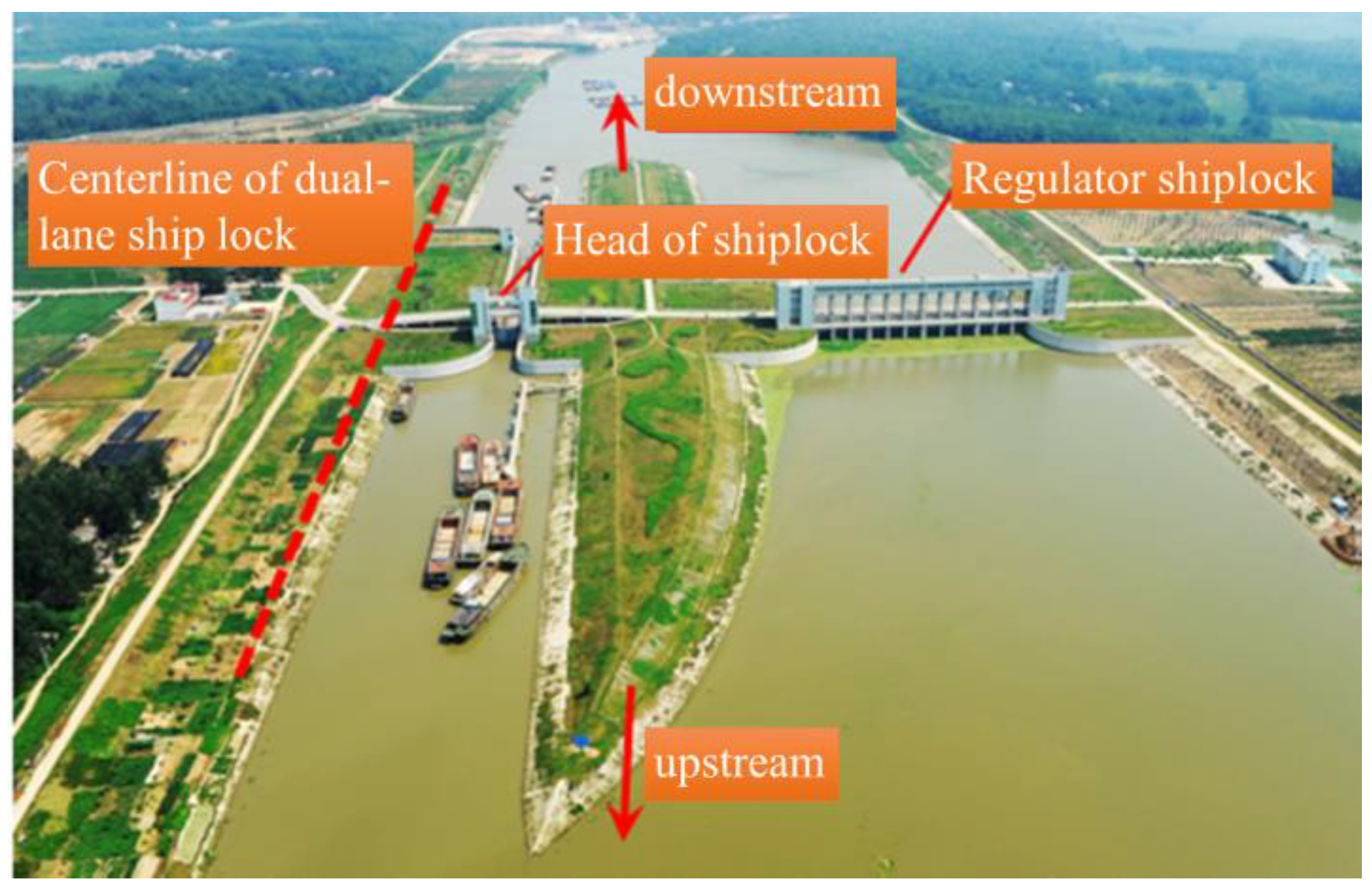

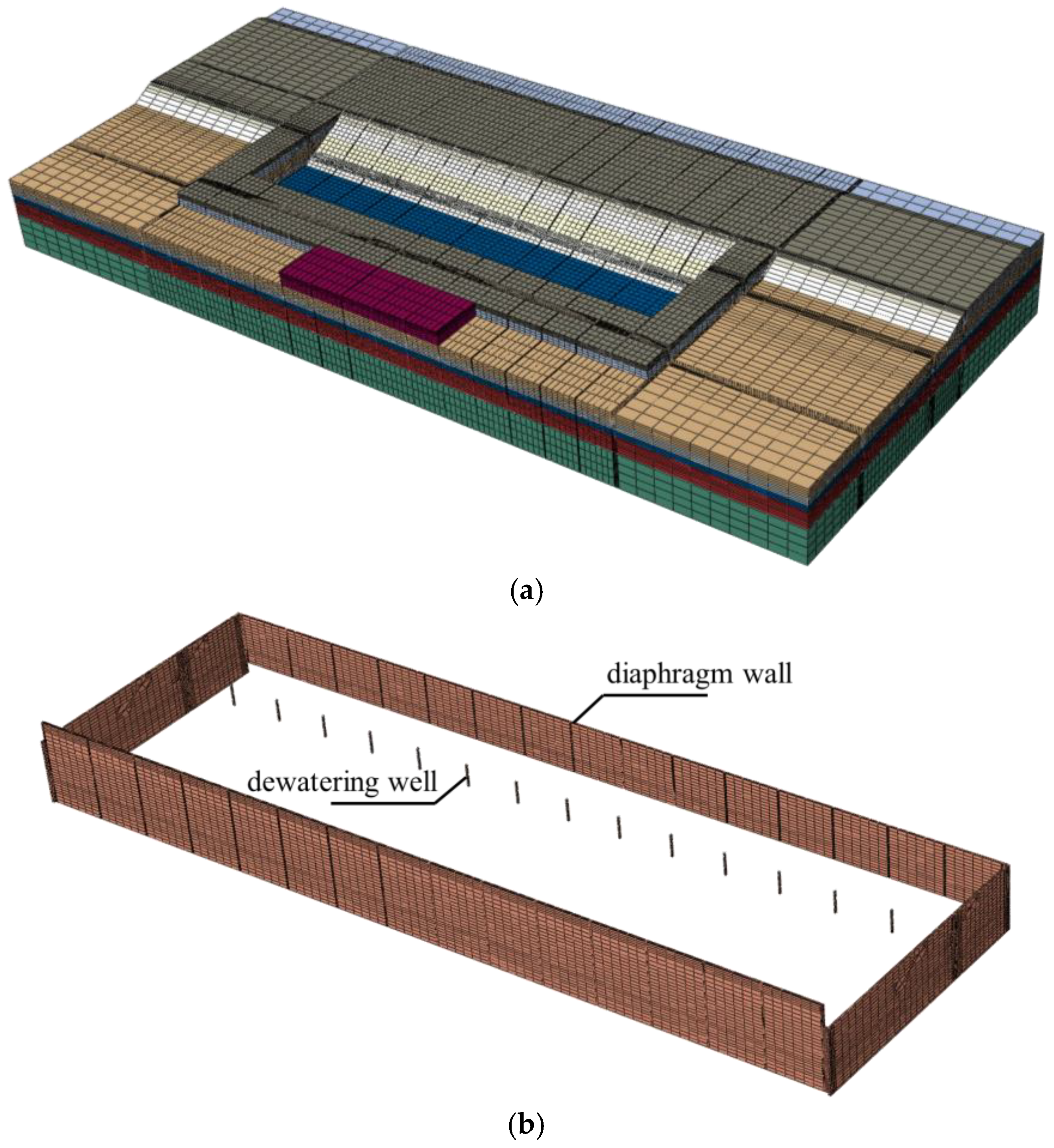

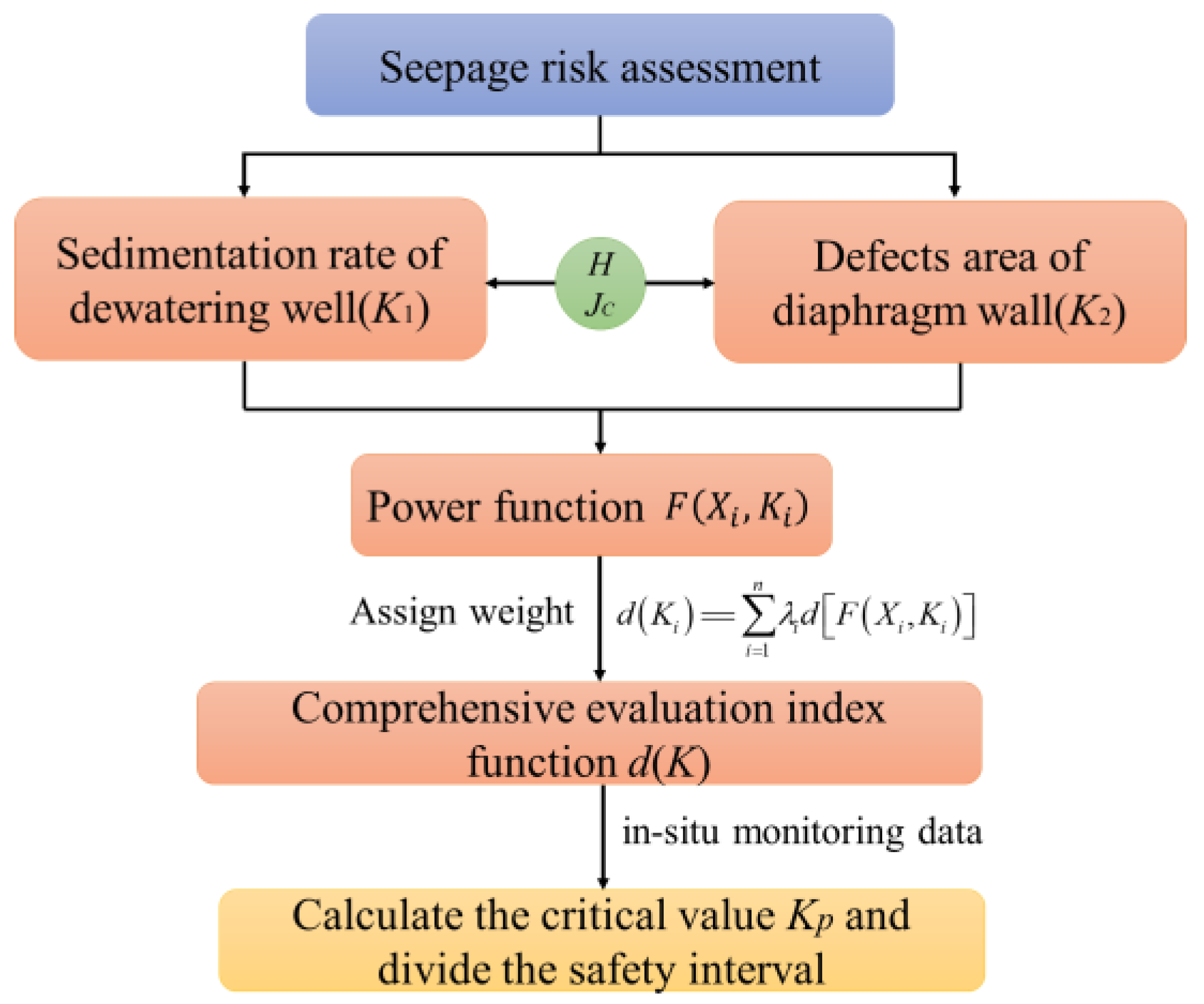


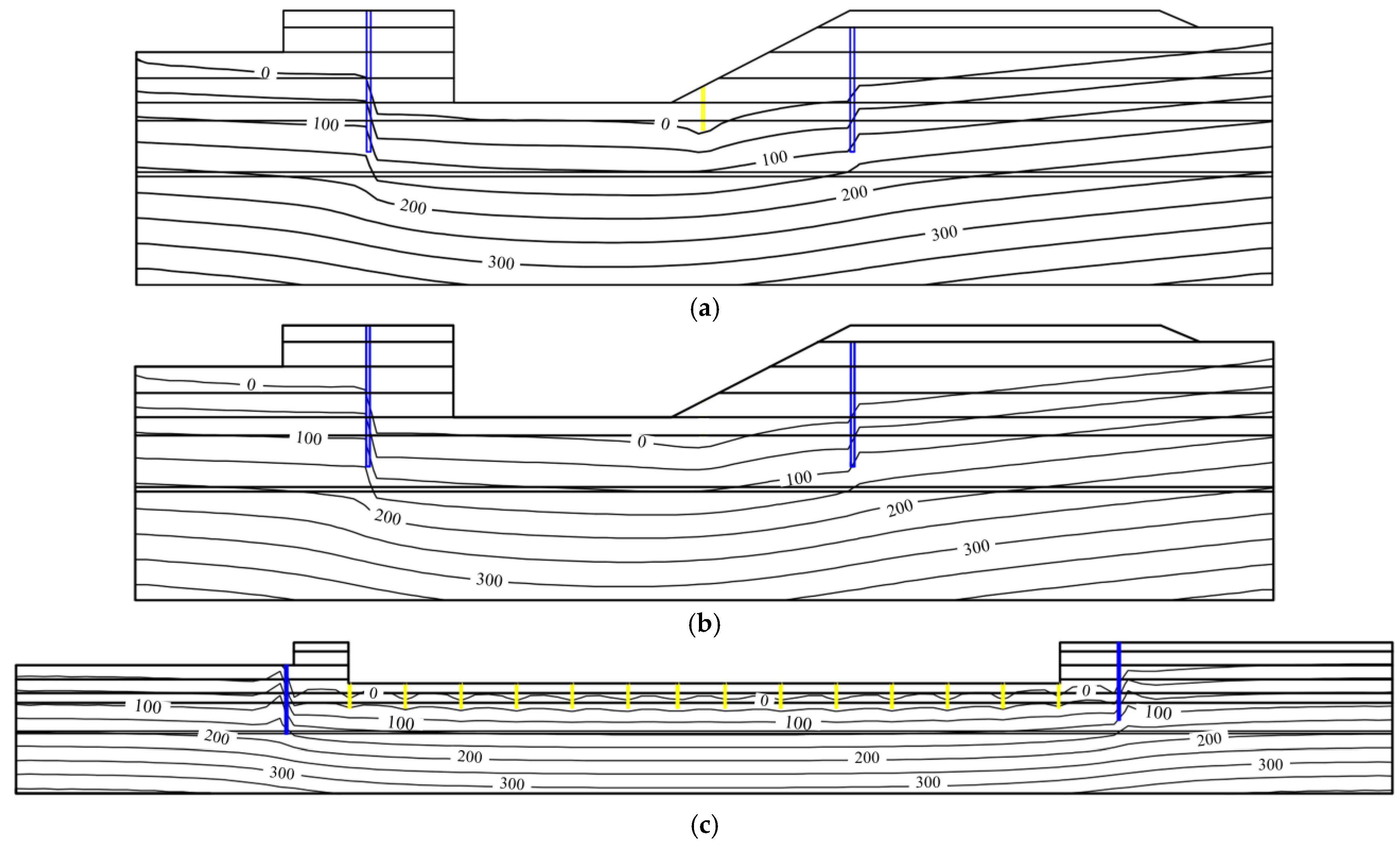






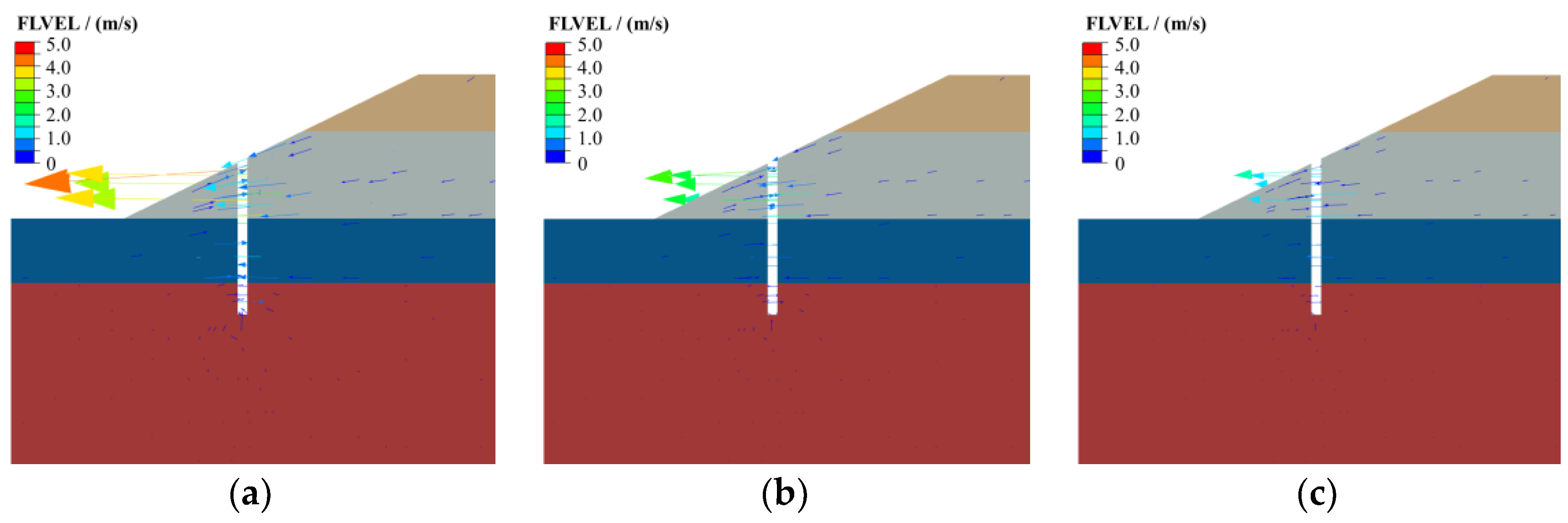




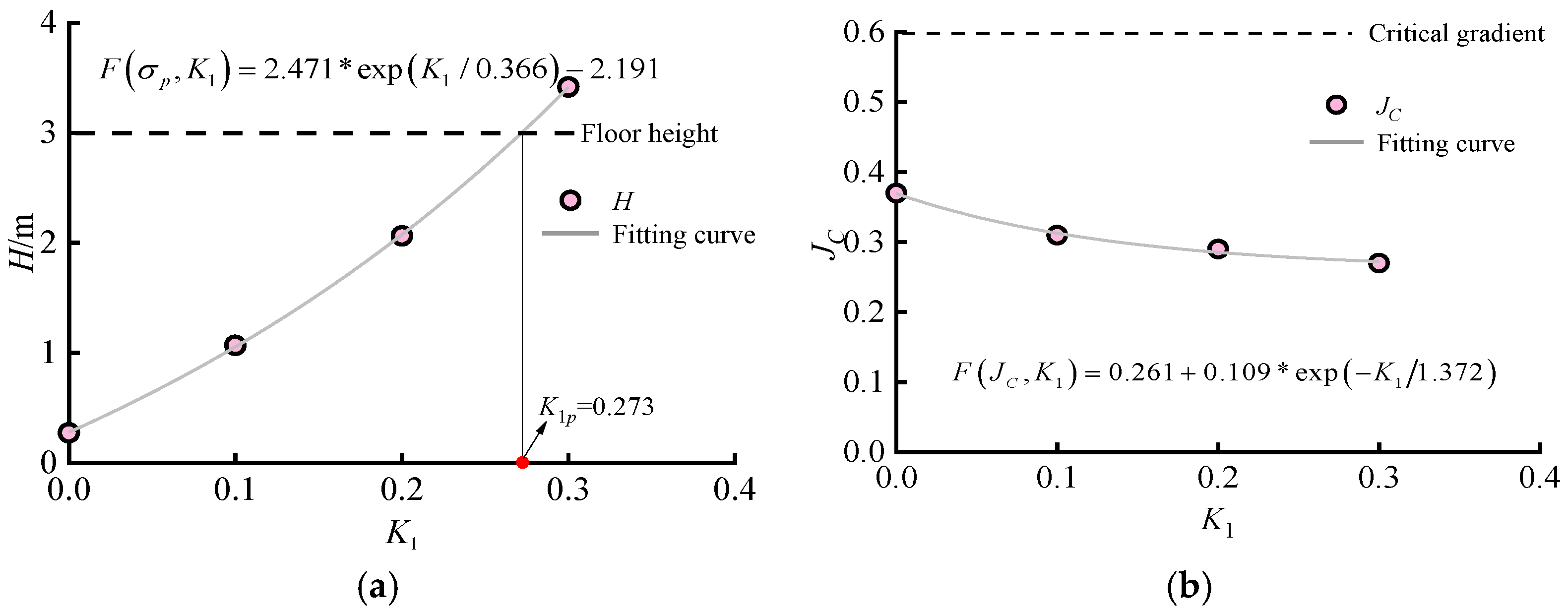
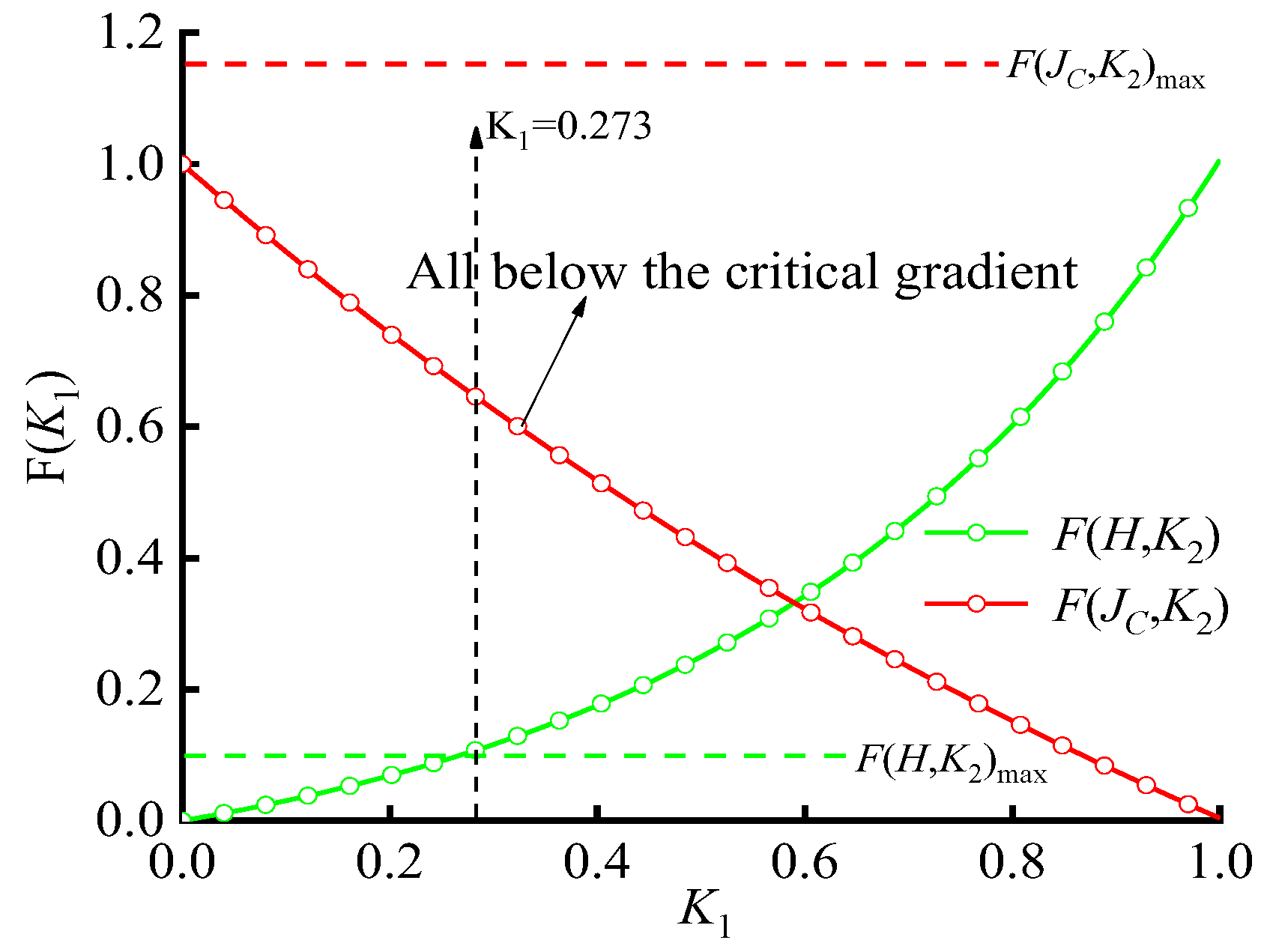
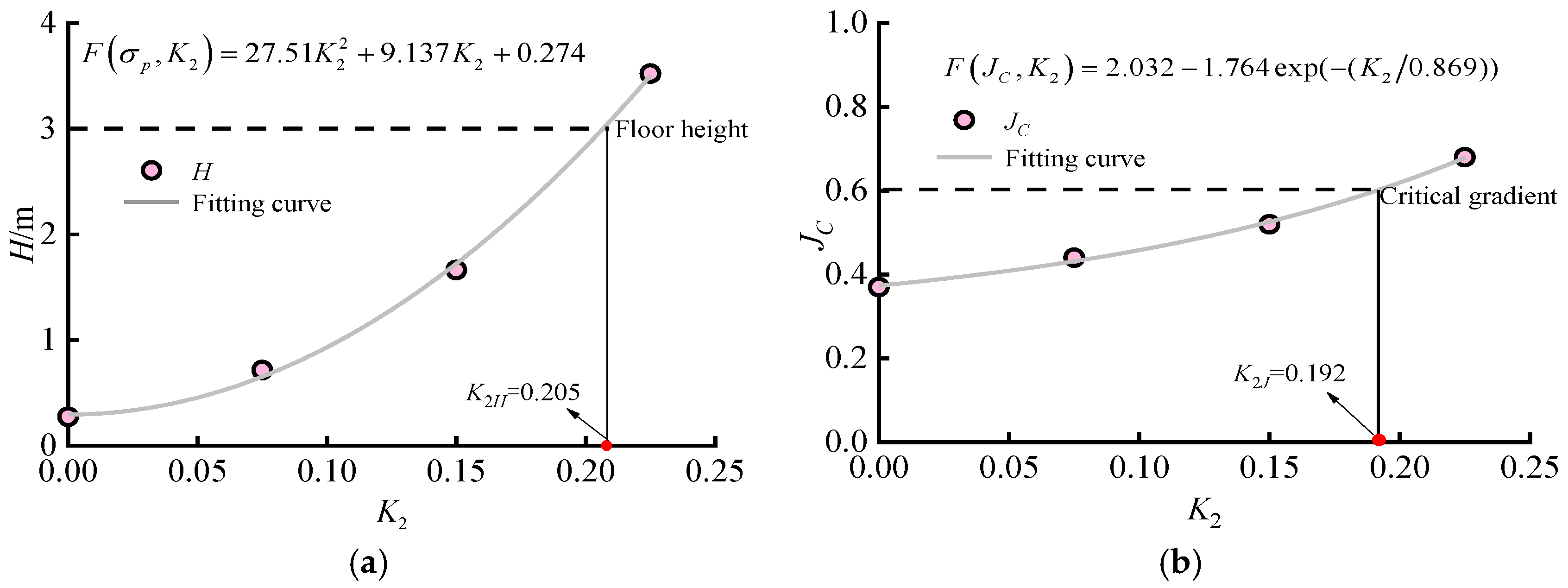

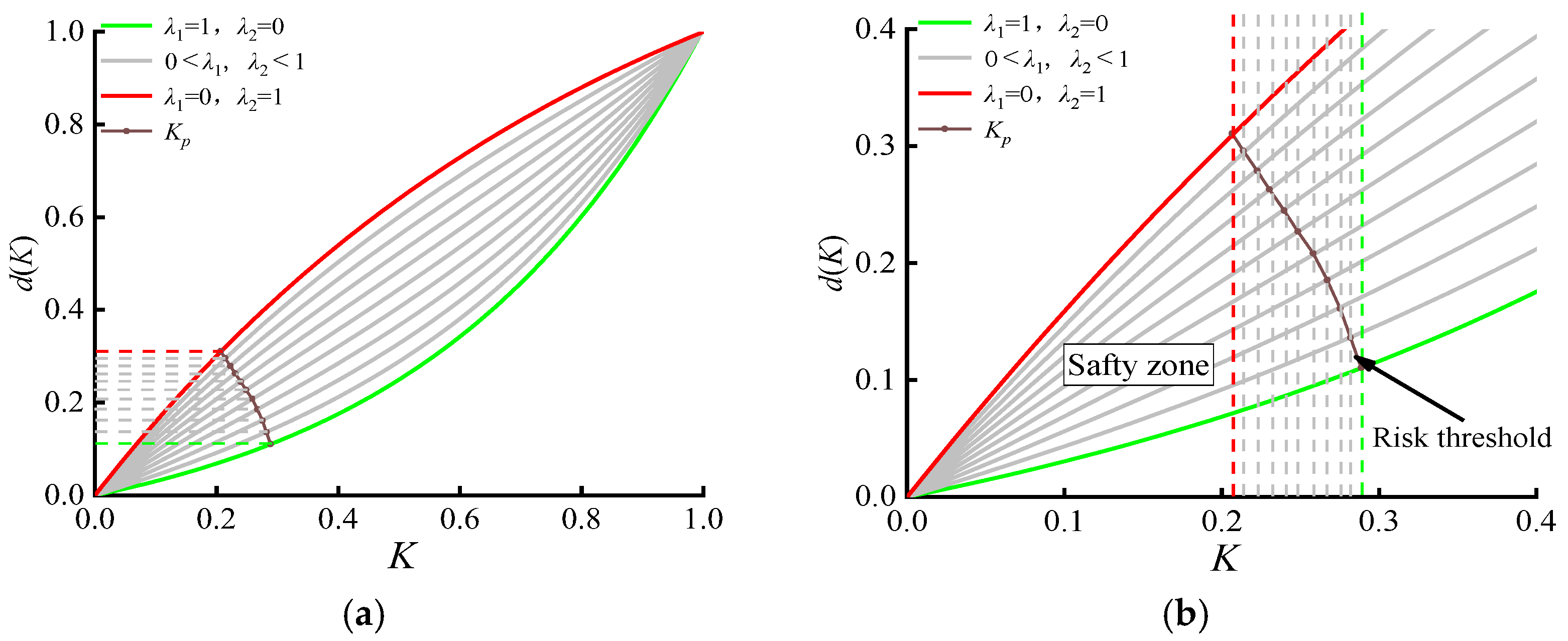
| Part | Elastic Modulus/Mpa | Poisson Ratio | Osmotic Coefficient (cm/s) | Pore Ratio | Density/g/cm3 | Critical Gradient |
|---|---|---|---|---|---|---|
| silty clay | 8.0 | 0.15 | 3.0 × 10−6 | 0.30 | 1.8 | 1.3 |
| silt loam | 5.5 | 0.25 | 8.0 × 10−6 | 0.50 | 2.1 | 0.8 |
| Silty-sandy interlayer | 2.5 | 0.25 | 3.0 × 10−4 | 0.40 | 2.5 | 0.6 |
| Sandy loam | 6.5 | 0.35 | 4.0 × 10−4 | 0.65 | 1.9 | 0.6 |
| silt loam | 7.5 | 0.30 | 5.0 × 10−6 | 0.60 | 2.2 | 1.2 |
| Fine sand | 7.5 | 0.30 | 1.0 × 10−3 | 0.55 | 1.8 | 0.5 |
| silt loam | 10.0 | 0.15 | 6.0 × 10−6 | 0.30 | 3.2 | 1.2 |
| dewatering well | 12.0 | 0.32 | 6.0 × 10−1 | 0.30 | 2.5 | - |
| diaphragm wall | 7.5 | 0.30 | 7.3 × 10−8 | 0.60 | 2.1 | - |
Disclaimer/Publisher’s Note: The statements, opinions and data contained in all publications are solely those of the individual author(s) and contributor(s) and not of MDPI and/or the editor(s). MDPI and/or the editor(s) disclaim responsibility for any injury to people or property resulting from any ideas, methods, instructions or products referred to in the content. |
© 2024 by the authors. Licensee MDPI, Basel, Switzerland. This article is an open access article distributed under the terms and conditions of the Creative Commons Attribution (CC BY) license (https://creativecommons.org/licenses/by/4.0/).
Share and Cite
Huang, J.; Xie, J.; Ren, H. Research on Safety Risk Evaluation System for Seepage in Ship Lock Foundation Pit Engineering. Buildings 2024, 14, 2972. https://doi.org/10.3390/buildings14092972
Huang J, Xie J, Ren H. Research on Safety Risk Evaluation System for Seepage in Ship Lock Foundation Pit Engineering. Buildings. 2024; 14(9):2972. https://doi.org/10.3390/buildings14092972
Chicago/Turabian StyleHuang, Jianhong, Jian Xie, and Honglei Ren. 2024. "Research on Safety Risk Evaluation System for Seepage in Ship Lock Foundation Pit Engineering" Buildings 14, no. 9: 2972. https://doi.org/10.3390/buildings14092972





